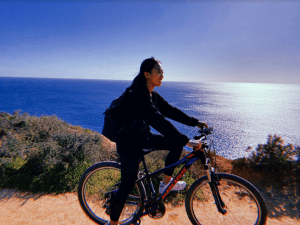Thursday, April 7, 2022 | Written by Claire
Every semester, most GTL students flock to Switzerland to enjoy the hiking, paragliding, and skiing, during the colder months. I could not miss seeing this beautiful country so my travel group and I decided to conquer the hike from Interlaken, a beautiful, quaint, Switzerland town, to Augstmatthorn, a grueling 10 hour hike that ends in Hardergrat where a shuttle bus would take us back to where we started. The elevation gain was around 1500m over a 24.8km journey. Our plan was simple: start at 4 am and then reach the mountain top to see the sunrise, continue our journey and finish around 2-3 pm.
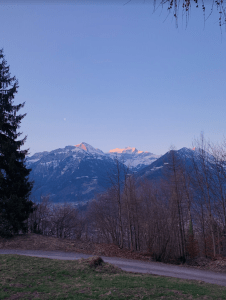 At first, our journey was smooth, we were able to catch a glimpse of the beautiful sunrise as it shimmered across the lake and reflected off the snow-covered mountains across from us. Preparation wise: we really loaded up on food. With 3L of water for each of us, a dozen or so ham sandwiches, 12 granola bars, a pack of Biscoff, 2 fruit squeezies, and a pack of Dutch Nutella cookies, we were set. However, in terms of gear, only one of us had hiking sticks and the rest of us managed to get around using regular school backpacks, tennis shoes, and our overall balance. That was where we made a grave mistake.
At first, our journey was smooth, we were able to catch a glimpse of the beautiful sunrise as it shimmered across the lake and reflected off the snow-covered mountains across from us. Preparation wise: we really loaded up on food. With 3L of water for each of us, a dozen or so ham sandwiches, 12 granola bars, a pack of Biscoff, 2 fruit squeezies, and a pack of Dutch Nutella cookies, we were set. However, in terms of gear, only one of us had hiking sticks and the rest of us managed to get around using regular school backpacks, tennis shoes, and our overall balance. That was where we made a grave mistake.
The hike to Augstmatthorn itself isn’t necessarily a challenging one, for us at least. Physically, the overall terrain wasn’t too rugged, it was just very steep and death defying in many places. However, hiking in March, the trail didn’t reveal itself to be dangerous until we completed 7 hours of hiking. As we reached further into the ridge-line, snow began to coat the ground. Some of it was packed and slippery, a menace for those with tennis shoes that had poor grip. Some of it was on the verge of melting, which was extremely dangerous as one wrong step could send the entire snow pile rolling down the ledge only a few inches away from our feet. On the other hand, the snow was cold and wet, numbing our feet perpetually and making it even more slippery.
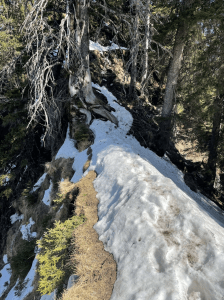 The trails became narrower and the ridge even steeper, with two sharp drops on both sides. We were ill-prepared to take on the trail any longer. When we were almost about the clear the trees, several experienced hikers had turned back, warning us that the ridgeline would be too snowy to continue, but we were determined to check out the scene for ourselves. Long story short- we turned back. The sharp drop was covered in packed, melting snow, the most dangerous combination. With our lack of equipment and expertise, we had to give up the hike. It was just too early in the year to reach Augstmatthorn.
The trails became narrower and the ridge even steeper, with two sharp drops on both sides. We were ill-prepared to take on the trail any longer. When we were almost about the clear the trees, several experienced hikers had turned back, warning us that the ridgeline would be too snowy to continue, but we were determined to check out the scene for ourselves. Long story short- we turned back. The sharp drop was covered in packed, melting snow, the most dangerous combination. With our lack of equipment and expertise, we had to give up the hike. It was just too early in the year to reach Augstmatthorn.
On the way back, we sighed a breath of slight heartbreak as we mentally prepared ourselves for the 7-hour journey back. We would reach Interlaken much after the sun goes down, but luckily three of us had flashlights that would hopefully last us a few hours. As we squeezed through a maze of logs, we spotted a sign: Ringgenberg, a 1.5-hour hike down to the nearby town where we could take the next train back to Interlaken. That turned out to be the worst decision of our lives. This trail took us on a steep, strenuous route that had an elevation loss of 1060m in a climb that was a fourth of the original trail length from Interlaken. The route was steep, winding, and extremely muddy. My shoes, once black, had turned brown, and dirt accumulated under my fingernails as we had to get on our hands and knees to stay balanced. Halfway down the mountain, the trail disappeared. The red and white markers vanished into a maze of fallen pines that completely blocked the path further down. There was no way past the tangle of spiny branches. Even the ground, once made of hardened dirt, had become a slush of mud and accumulated snow. We were stuck. As we sat there, covered in mud and becoming increasingly cold, we felt a wave of panic as the sun began to dip over the ridge and we were no where near the town that was thousands of feet below us… until we thought of another way to reach there: slide. The trail had opened to a grassy slope of long weeds and small tree saplings. The slope was long, but not extremely steep, and near the bottom, we could see the opening to the road leading to the town. Fighting against the time and desperate to get back home, we decided to go for it and slide down the slope.
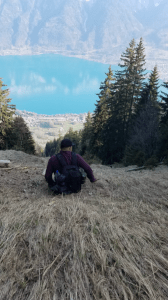 Slowly inching our way down, we were able to scoot slowly over the grass, with one of two terrifying moments when we would lose control over patches of slippery grass, grabbing desperately onto the weeds for some stability. In the end, after 40 miserable minutes of sliding, slipping, and sprawling on the ground to slow our descent, we made it to a flatter ledge on the side. Just getting to the ledge was difficult enough, spreading into a sea star and grabbing the small tree saplings to pull us over to safety. Finally, we had made it. Miraculously, just several meters away was flat ground that looked relatively clear of snow and mud. The trail. Somehow, we had made it to the same trail just further down the mountain, saving us a hundred meters or so of downhill hiking. From there, we hustled down the mountain, almost running as we heard strange animal sounds and breaking branches coming from deep within the forest. After another hour, we collapsed onto the pavement, relieved, exhausted, and elated to be one step closer to home… sike.
Slowly inching our way down, we were able to scoot slowly over the grass, with one of two terrifying moments when we would lose control over patches of slippery grass, grabbing desperately onto the weeds for some stability. In the end, after 40 miserable minutes of sliding, slipping, and sprawling on the ground to slow our descent, we made it to a flatter ledge on the side. Just getting to the ledge was difficult enough, spreading into a sea star and grabbing the small tree saplings to pull us over to safety. Finally, we had made it. Miraculously, just several meters away was flat ground that looked relatively clear of snow and mud. The trail. Somehow, we had made it to the same trail just further down the mountain, saving us a hundred meters or so of downhill hiking. From there, we hustled down the mountain, almost running as we heard strange animal sounds and breaking branches coming from deep within the forest. After another hour, we collapsed onto the pavement, relieved, exhausted, and elated to be one step closer to home… sike.
The pavement we landed on had no direct route down to the town of Ringgenberg. Instead, it weaved back and forth on the mountain as it descended from the slopes. The walk would take at least 45 more minutes and the sun was almost completely gone. We were losing hope. There was not a single light in sight and just more and more rolling hills. We were thinking of cutting across but our muddied shoes would not have made it up those hills to begin with. Then we walked, further and further down the pavement road towards the town, losing hope and spirit. Until yet another miracle, a duo of Swiss guys were coming up the road. Parked to the right was a caravan, big enough to hold at least 10 people. They were our saving grace. They had offered us a ride down to the town, and we willingly said yes, crowding into their van looking tired and hungry. After a short 10-minute ride, we were outside the Ringgenberg train station. We made it to safety.
On the same night, after we reached our hotel in Geneva on the French border, someone set our hotel on fire, and we escaped out of the burning building just as black smoke began to fill the room. More on this in another blog.
As a lesson, this trip was by far one of the most adrenaline-inducing, death-defying, and life-changing experiences I’ve ever had in my life. Hiking in Switzerland is no easy task, and you need to be prepared with the right gear to conquer the terrain. Our journey is just an example of what you SHOULDN’T do when hiking dangerous trails anywhere in the world. And I hope that whoever goes hiking on that same trail won’t have the same experience as us.
To find out more details about what happened on the hike: check out my vlog on my YouTube channel.

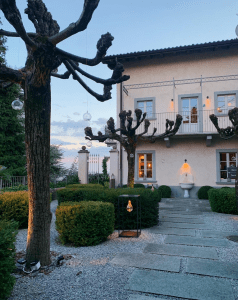 As the sun rose high in the sky, I was delighted to feel the warm rays bathed across my face and the fresh breeze. It was a definite change up from the weather in Metz, where it was perpetually grey and gloomy seven days a week. The city itself was beautiful. The town was lined with colorful houses of pastel orange, yellow, and red. The small little alleyways of the quaint Italian town seemed to emerge from stone, stacked upon each other creating small winding trails on the cliffs above the water, which shimmered a beautiful crystal-turquoise color as small private boats settled on the surface, rocking peacefully back and forth. Although the trees were still on their early spring phase, the leaf-less branches created intricate shapes and patterns that weaved higher in the sky, a natural masterpiece.
As the sun rose high in the sky, I was delighted to feel the warm rays bathed across my face and the fresh breeze. It was a definite change up from the weather in Metz, where it was perpetually grey and gloomy seven days a week. The city itself was beautiful. The town was lined with colorful houses of pastel orange, yellow, and red. The small little alleyways of the quaint Italian town seemed to emerge from stone, stacked upon each other creating small winding trails on the cliffs above the water, which shimmered a beautiful crystal-turquoise color as small private boats settled on the surface, rocking peacefully back and forth. Although the trees were still on their early spring phase, the leaf-less branches created intricate shapes and patterns that weaved higher in the sky, a natural masterpiece. 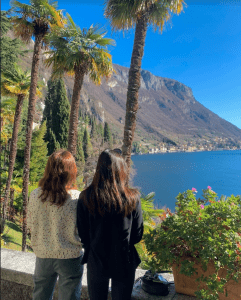
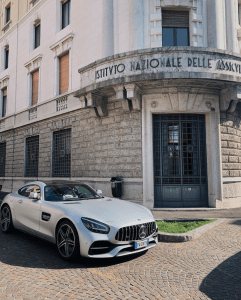 Finally, in Bellagio, we hopped off the ferry right on time to catch the glorious sunset, a ball of bright red that dipped below the horizon. As the sun disappeared, the cold started to set in, coupled with the strong winds that ripped our hair back and forth. As we took a look at the time, we would be right on time to catch the last bus back to the train station in Varenna, which would bring us back to the hotel. We stood in the dark corner of the bus station, waiting as the time ticked past its scheduled arrival. As the moon continued to rise higher into the sky, the bus finally showed up, only to be packed to the BRIM with passengers huddled like sardines on board. There was no room to spare. The driver, however, didn’t even stop; instead, we took one look at our shivering selves at the bus station, shrugged, and sped away. Our hearts sank. There was no way back. We stood there in silence for a minute pondering on what to do, but not too far from the dock, we saw a ferry pulling up to the station. It seemed to be running on schedule despite the strike. At once, we bolted on board only to find twenty other people trying to get to the same train station to catch the next train that would supposedly leave 5 minutes after the ferry arrives.
Finally, in Bellagio, we hopped off the ferry right on time to catch the glorious sunset, a ball of bright red that dipped below the horizon. As the sun disappeared, the cold started to set in, coupled with the strong winds that ripped our hair back and forth. As we took a look at the time, we would be right on time to catch the last bus back to the train station in Varenna, which would bring us back to the hotel. We stood in the dark corner of the bus station, waiting as the time ticked past its scheduled arrival. As the moon continued to rise higher into the sky, the bus finally showed up, only to be packed to the BRIM with passengers huddled like sardines on board. There was no room to spare. The driver, however, didn’t even stop; instead, we took one look at our shivering selves at the bus station, shrugged, and sped away. Our hearts sank. There was no way back. We stood there in silence for a minute pondering on what to do, but not too far from the dock, we saw a ferry pulling up to the station. It seemed to be running on schedule despite the strike. At once, we bolted on board only to find twenty other people trying to get to the same train station to catch the next train that would supposedly leave 5 minutes after the ferry arrives. 
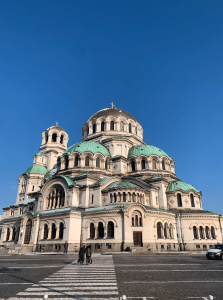 Bulgaria was a place with very rich history and deep national pride. Their cultural norms were rooted for centuries, passed down from family and family. And one of the first influences I noticed was the presence of Eastern Orthodox churches and mosques. Located in the heart of Sofia is St. Alexander’s Basilica. Its brutal architecture featured green and golden domes with large, arche
Bulgaria was a place with very rich history and deep national pride. Their cultural norms were rooted for centuries, passed down from family and family. And one of the first influences I noticed was the presence of Eastern Orthodox churches and mosques. Located in the heart of Sofia is St. Alexander’s Basilica. Its brutal architecture featured green and golden domes with large, arche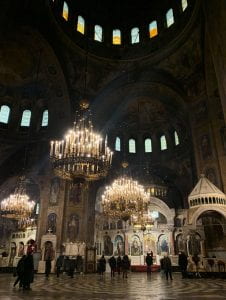 Inside, the atmosphere was even more unique. As we slowly entered, many Bulgarians would bow at the entrance and before the cross while performing the traditional Catholic crossbody hand gestures. The Basilica itself was very dimly lit with giant chandeliers that hung lowly from the ceiling. Paintings along the walls had darker undertones, featuring a more gothic approach than the fresh rococo style seen in Spain or Italy. There was a priest standing at the front of the sanctuary reading script in worship. His low, melodic yet monotone voice sent shivers down my spine. It was unlike anything I’ve seen or heard before.
Inside, the atmosphere was even more unique. As we slowly entered, many Bulgarians would bow at the entrance and before the cross while performing the traditional Catholic crossbody hand gestures. The Basilica itself was very dimly lit with giant chandeliers that hung lowly from the ceiling. Paintings along the walls had darker undertones, featuring a more gothic approach than the fresh rococo style seen in Spain or Italy. There was a priest standing at the front of the sanctuary reading script in worship. His low, melodic yet monotone voice sent shivers down my spine. It was unlike anything I’ve seen or heard before.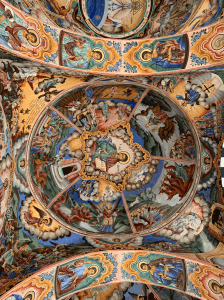
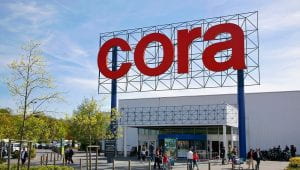 This is the biggest market in Metz and its definitely one you can’t miss. Basically a Walmart and Target combined into a Costco sized warehouse, Cora is the place to find anything you ever need. There are huge selections of housewares, clothing, pastries, meats, and drinks of all sorts. While prices are not much cheaper than those back in Atlanta, it depends on the meats, fruits, and veggies you end up buying. Tropical fruits, such as strawberries, grapes, and mangos are very expensive, almost 1.5 the price than we usually see at home. Meat cuts include parts from all parts of cows, pigs, and chicken, but the one thing you want to keep in mind when selecting cheaper meat is the date of consumption. Many times, the meats must be eaten within the next 1-3 days, so if you’re traveling on the weekend, it’s best to buy the groceries after you return. Overall, Cora scores a 10/10 on the scale. It has almost everything I ever needed and while it’s a 30-minute walk from Lafayette, with the metro pass, you can get there in a matter of minutes.
This is the biggest market in Metz and its definitely one you can’t miss. Basically a Walmart and Target combined into a Costco sized warehouse, Cora is the place to find anything you ever need. There are huge selections of housewares, clothing, pastries, meats, and drinks of all sorts. While prices are not much cheaper than those back in Atlanta, it depends on the meats, fruits, and veggies you end up buying. Tropical fruits, such as strawberries, grapes, and mangos are very expensive, almost 1.5 the price than we usually see at home. Meat cuts include parts from all parts of cows, pigs, and chicken, but the one thing you want to keep in mind when selecting cheaper meat is the date of consumption. Many times, the meats must be eaten within the next 1-3 days, so if you’re traveling on the weekend, it’s best to buy the groceries after you return. Overall, Cora scores a 10/10 on the scale. It has almost everything I ever needed and while it’s a 30-minute walk from Lafayette, with the metro pass, you can get there in a matter of minutes. 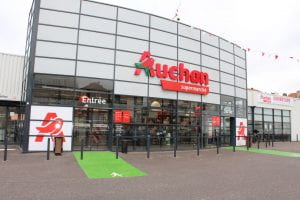 Auchan is a smaller chain supermarket that is closer to Lafayette than Cora. It sells mostly the same things and brands, but overall, Auchan has higher quality pastries and good budget food items. While the veggies selection is not as diverse, it specializes in lot of bio or organic produce that are slightly cheaper than the ones at Cora. From my experience, it is best to go to Auchan earlier in the day when things have been stocked up and when the bakeries just restock on their fresh breads. It scores brownie points for its convenient location and accessibility to Lafayette. Finally, most French groceries stores are highly plastic conscious, so you’ll have to bring your own bags!
Auchan is a smaller chain supermarket that is closer to Lafayette than Cora. It sells mostly the same things and brands, but overall, Auchan has higher quality pastries and good budget food items. While the veggies selection is not as diverse, it specializes in lot of bio or organic produce that are slightly cheaper than the ones at Cora. From my experience, it is best to go to Auchan earlier in the day when things have been stocked up and when the bakeries just restock on their fresh breads. It scores brownie points for its convenient location and accessibility to Lafayette. Finally, most French groceries stores are highly plastic conscious, so you’ll have to bring your own bags! 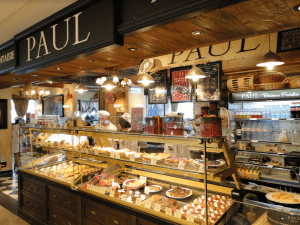 For new French pastry connoisseurs, Paul’s is the perfect place to start exploring. Located just 5 minutes away from GTL, Paul’s has a huge collection of coffees, breads, tarts, and ready-made food just for your convenience. For my first time at Paul’s, I tried their pain au chocolat, a classic French delicacy with chocolate folded into crispy, buttery goodness. Their tarts are amazing with fresh berries and a glaze that isn’t too sweet but also not too sour. Their freshly made baguettes in the morning are perfect for cheese and jam. Overall, the prices are comparable to those in Cora, so you might as well try out what they have and expand your horizons. There are also many tables set up inside for you to get your work done, in an ambient, cozy environment with your favorite pastries. While taste is good, the waiter experience was slightly awkward when we first visited there. If you do not know French, you might want to touch up on some of your basic French phrases before heading over.
For new French pastry connoisseurs, Paul’s is the perfect place to start exploring. Located just 5 minutes away from GTL, Paul’s has a huge collection of coffees, breads, tarts, and ready-made food just for your convenience. For my first time at Paul’s, I tried their pain au chocolat, a classic French delicacy with chocolate folded into crispy, buttery goodness. Their tarts are amazing with fresh berries and a glaze that isn’t too sweet but also not too sour. Their freshly made baguettes in the morning are perfect for cheese and jam. Overall, the prices are comparable to those in Cora, so you might as well try out what they have and expand your horizons. There are also many tables set up inside for you to get your work done, in an ambient, cozy environment with your favorite pastries. While taste is good, the waiter experience was slightly awkward when we first visited there. If you do not know French, you might want to touch up on some of your basic French phrases before heading over. 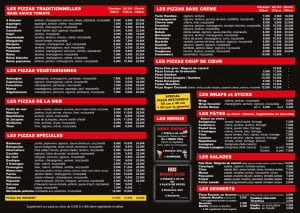 Funny enough, Mamma Mia
Funny enough, Mamma Mia 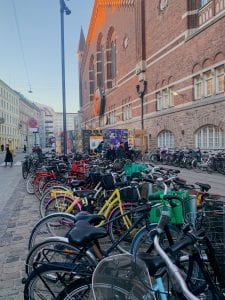 Bikes:
Bikes: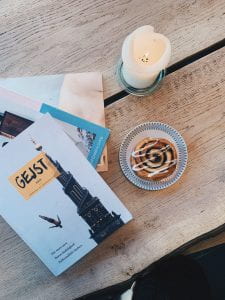
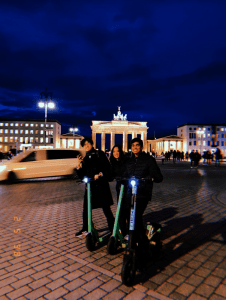 block.
block. 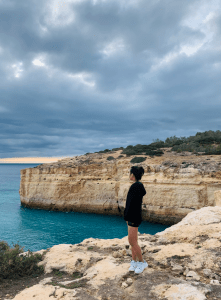 For the nature enthusiasts, hiking is always a cheap option that you can tailor to your experiences and preferences. Many big cities in Europe are located next to mountainous regions or along the coast. For example, if you travel to Marseille in France, you can scale the Calanques for a whole day without spending a single cent. In many of the port cities, you can find rocky outcrops to bask in the sunlight or take a stroll along the beach. If you’re in Italy or Portugal, there are many lakes such as Lake Como or the Benagil Caves that you can spend your afternoon exploring. While extra activities such as mountain biking or sea kayaking may cost 10-30 euros, the views are spectacular and worth the cost.
For the nature enthusiasts, hiking is always a cheap option that you can tailor to your experiences and preferences. Many big cities in Europe are located next to mountainous regions or along the coast. For example, if you travel to Marseille in France, you can scale the Calanques for a whole day without spending a single cent. In many of the port cities, you can find rocky outcrops to bask in the sunlight or take a stroll along the beach. If you’re in Italy or Portugal, there are many lakes such as Lake Como or the Benagil Caves that you can spend your afternoon exploring. While extra activities such as mountain biking or sea kayaking may cost 10-30 euros, the views are spectacular and worth the cost. 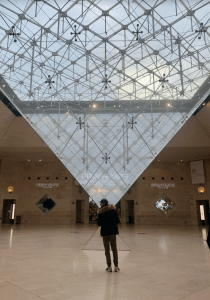 As a student, you’re in luck. Many museums such as the Prado in Madrid are free for students on certain weekends. If they are not free, exhibition tickets are often sold at a discounted rate if you have your ISIC card on you. These museums often hold gems of modern, historical art, and they can eat up a whole day of activities if you’re interested. Not only are these museums specific to the region, they also have different exhibitions every month.
As a student, you’re in luck. Many museums such as the Prado in Madrid are free for students on certain weekends. If they are not free, exhibition tickets are often sold at a discounted rate if you have your ISIC card on you. These museums often hold gems of modern, historical art, and they can eat up a whole day of activities if you’re interested. Not only are these museums specific to the region, they also have different exhibitions every month. 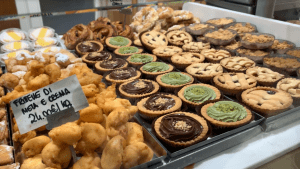 For the foodies, a cheap way to try local foods is to go bakery hopping. Many small goodies cost one or two euros and are pretty filling. They also represent the local cuisine with each baked good. For example, in Faro, Portugal, we tried Portuguese egg tarts that are a euro and custard sponge cakes, which the locals were crazed about. In Italy, we also had cheap cannolis and pistachio buns for under a euro. In Como, they sold pastries by the bag, and we lived off them for only 7 euros throughout the entire day.
For the foodies, a cheap way to try local foods is to go bakery hopping. Many small goodies cost one or two euros and are pretty filling. They also represent the local cuisine with each baked good. For example, in Faro, Portugal, we tried Portuguese egg tarts that are a euro and custard sponge cakes, which the locals were crazed about. In Italy, we also had cheap cannolis and pistachio buns for under a euro. In Como, they sold pastries by the bag, and we lived off them for only 7 euros throughout the entire day. 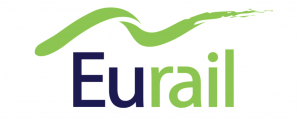
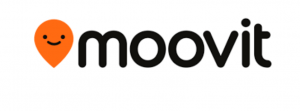
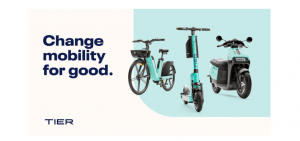

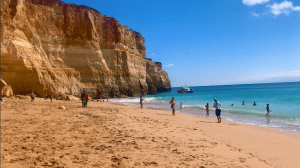
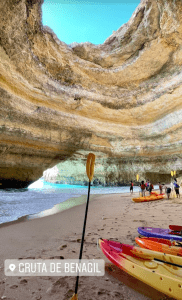 If you want an up close and personal look at caves, go sea kayaking with a guided tour. Those people can help you get to certain landmarks such as the crocodile rock while telling you stories about how the rocks formed. Not only do these tour guides help you dock your kayaks, but they’ll also help you get back on board in case you flip! Sea Kayaking is a great way to be immersed in the natural beauty while paddling close to the water without getting drenched in the cold waters during the winter. You’ll get an adrenaline rush from racing through the waves and get a waft of cool, ocean breeze while basking in the warmth of the sunlight.
If you want an up close and personal look at caves, go sea kayaking with a guided tour. Those people can help you get to certain landmarks such as the crocodile rock while telling you stories about how the rocks formed. Not only do these tour guides help you dock your kayaks, but they’ll also help you get back on board in case you flip! Sea Kayaking is a great way to be immersed in the natural beauty while paddling close to the water without getting drenched in the cold waters during the winter. You’ll get an adrenaline rush from racing through the waves and get a waft of cool, ocean breeze while basking in the warmth of the sunlight. 